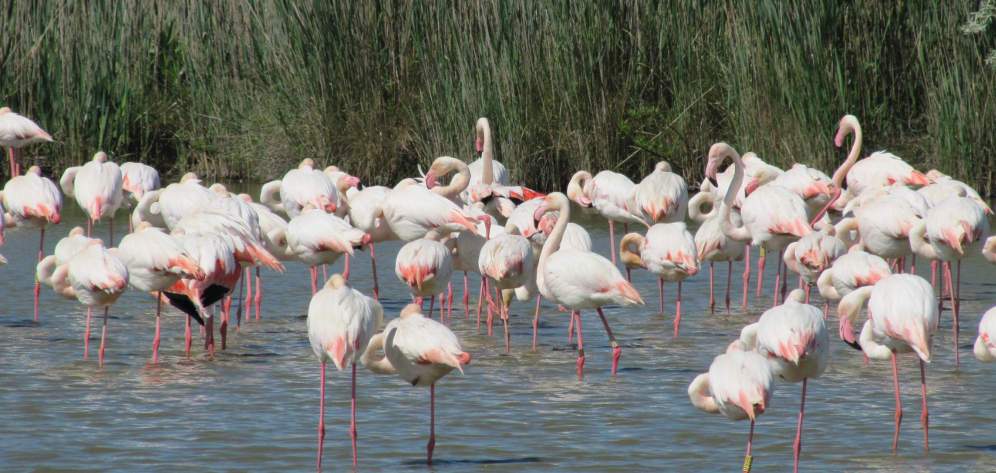
The Camargue - a short guide
The
Camargue
- between sky and sea
- Explore France ►
- Essential pages
- Travel in France
- Where to go
- What to see and do
About-France.com
- the connoisseur's guide to France
| Go to ► | Camargue natural park | Camargue horses |
| Provence region | Accommodation | Other ideas |

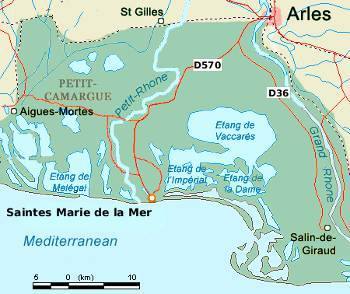
Camargue essential information
Location: on the Mediterranean coastRegions: Provence
Alpes Côte d'Azur and Languedoc
Nearby attractions and other places: Nimes, Arles,
Nearest airports to the Camargue: Nîmes, Marseille Provence.
Nearby attractions and other places: Nimes, Arles,
Nearest airports to the Camargue: Nîmes, Marseille Provence.
Access from Calais:
Route via A 26 > Lyon > A7, then via Arles or Nimes.
Few areas of France are as distictive as the Camargue; and apart from dramatic mountain areas, few are as interesting and offer such a range of ourdoor activities. Bird-watching, horse riding, pony-trekking for all (no experience needed), equestrian events, hiking, cycling, riverboat trips, some wonderful and remote Mediterranean beaches, and a world-famous gypsy pilgrimage each year in May; the Camargue has all this, and more.
The Camargue Natural Park
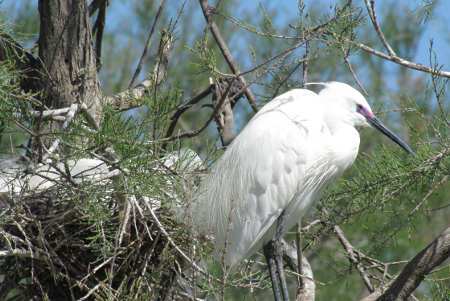 The
Camargue Natural Park
area, which includes a large UNESCO designated biosphere reserve, can
be visited at any time of the year, but the best times are in the
Spring and the Autumn,
when the park's wetlands are a major staging
point for hundreds of thousands of migrating birds. It is
notably
at this time of the year that the Camargue attracts bird-watchers from
all over Europe. But visitors come to the area throughout the year to
admire its wildlife, and in particular the thousands of pink flamingos.
These can be admired on many of the park's shallow expanses of water,
but most easily in the Camargue ornithological park, a bird park just
north of Saintes Marie de la Mer. The centre, with its kilometres of
trails, is home to many varieties of waterfowl, including flamingos,
white egrets and herons; it also has a bird hospital.
The
Camargue Natural Park
area, which includes a large UNESCO designated biosphere reserve, can
be visited at any time of the year, but the best times are in the
Spring and the Autumn,
when the park's wetlands are a major staging
point for hundreds of thousands of migrating birds. It is
notably
at this time of the year that the Camargue attracts bird-watchers from
all over Europe. But visitors come to the area throughout the year to
admire its wildlife, and in particular the thousands of pink flamingos.
These can be admired on many of the park's shallow expanses of water,
but most easily in the Camargue ornithological park, a bird park just
north of Saintes Marie de la Mer. The centre, with its kilometres of
trails, is home to many varieties of waterfowl, including flamingos,
white egrets and herons; it also has a bird hospital.Camargue horses and riding
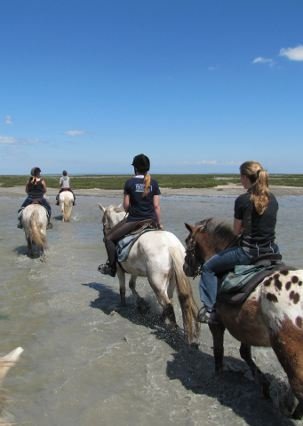 While the flamingos are the Camargue's most emblematic birds, the area
is more historically famous for its white horses. The Camargue's horses
are a special breed, reputedly one of the oldest breeds of horses in
the world, and they have lived in the very particular environment of
the Camargues saline wetlands for thousands of years.
While
some live in semi-wild conditions, most are now used either by the
Camargue's traditional cowboys, for herding and rounding up the area's
distinctive black bulls, or else for pony trekking.
While the flamingos are the Camargue's most emblematic birds, the area
is more historically famous for its white horses. The Camargue's horses
are a special breed, reputedly one of the oldest breeds of horses in
the world, and they have lived in the very particular environment of
the Camargues saline wetlands for thousands of years.
While
some live in semi-wild conditions, most are now used either by the
Camargue's traditional cowboys, for herding and rounding up the area's
distinctive black bulls, or else for pony trekking. Riding:
There are plenty of opportunities for horse riding in the Camargue, with riding stables beside many roads, particularly around Les Saintes Marie de la Mer. Most of these stables cater largely for tourists, and will take anyone out on a trek across the fields or the salt marshes – no experience needed. Rates are cheap - from 20 € an hour, 25 € for an hour and a half (2025 rates). Often it's just a question of turn up and go - or book, and come back for the next available ride. Many stables also run half-day treks and day treks, but it is best to check out with the local tourist office in advance, and book ahead; this is particularly recommended for experienced riders who are looking for more than just a wander round the Camargue at walking pace.
See and do : Other activities and places
- Hiking, cycling and beaches - The Camargue offers great hiking and cycling opportunities for those who like flat terrain and no hills. There are tracks and trails across the Rhone delta. To the east of Saintes Marie, there are miles of largely deserted sandy beaches, only accessible along tracks or on foot, on horseback or bike. Some places are accessible by car, but not all.
- Bullfights and bull runs: Camargue bullfights - courses camarguaises - are not like Spanish bullfights. Camargue bullfights are a competition of agility between men dressed in white, and black bulls; the aim is for the bullfighters to steal the trophies, such as ribbons and tassles and rosettes, that are placed between the bull's horns. In the Camargue tradition of bullfighting, there are no matadors, and the bulls are not killed. However Spanish-style bullfighting is also popular around the Camargue area, with major classic bullfighting events in the Arenas at Nimes and Arles.
- Salt
and rice : Apart from its bulls and its horses, the
Camargue is also famous for its salt and its rice. Rice has
been produced in the Camargue since the Middle Ages, and today there
are some 200 rice producers and over 20,000 hectares of rice paddies in
this small area, representing about 5% of rice production in Europe;
furthermore, production in on the increase. Camargue's unique "red
rice" is a popular local souvenir.
For an unusual trip, take the D36 road south from Arles, on the west bank of the Rhone. the journey will take you through rice paddies and marshes, down to the salt pans and salt mountains south of the village of Salin de Giraud. South of Salin de Giraud, after the salt mountains, after the wetlands, the road - now D36D - just peters out on an often-but-not-always lonely bit of beach, where it can go no further. 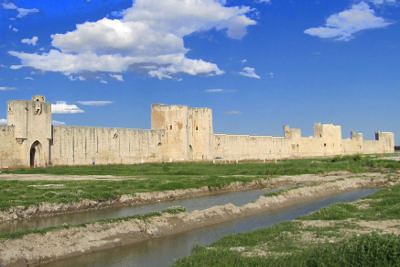 Aigues
Mortes - On the western edge of the Camargue area lies
the remarkable walled
city of Aigues Mortes. In medieval times, this was the Mediterranean
port from which the Crusaders set out, and it was on the coast. Since
then, the Rhone delta has silted up, and Aigues Mortes is five miles
inland, rising up out of the marshes.
Aigues
Mortes - On the western edge of the Camargue area lies
the remarkable walled
city of Aigues Mortes. In medieval times, this was the Mediterranean
port from which the Crusaders set out, and it was on the coast. Since
then, the Rhone delta has silted up, and Aigues Mortes is five miles
inland, rising up out of the marshes.
Aigues-Mortes is one of the finest walled cities in France, and it is possible to walk round the old city walls, which are largely intact. The ramparts are floodlit at night.
- Rhone river trips Just outside Saintes Marie, there are cruises on the Petit Rhône river, on board the Tiki, made up to look like a Mississippi paddle steamer.
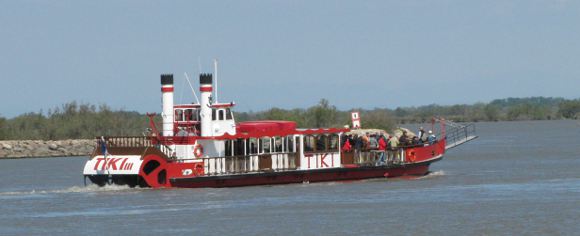
Not
quite the Mississippi.... but a riverboat trip on the Rhone Delta is a
fun outing for the family
Copyright
© About-France.com except where otherwise stated.
About-France.com
Home
page - Site
search
- Regions
- Maps of France
- Contact
Camargue
accommodation
This
link lists accommodation in order of distance from Saintes Marie de la
Mer, from
nearest to furthest (35 km).About-France.com
is an independent user-supported website
that does not track visitors and carries very little advertising, Links
to carefully selected affiliate partner websites may generate
commission on sales at no cost to the user.

►
Camargue
tourist information
There
are tourist information offices in Arles and Les Saintes Marie de la
Mer.► Staying in the Camargue
While there are a fair number of hotels and bed and breakfasts in the Camargue park area, notably in Saintes Marie, they are mostly small establishments Click here for details. Booking ahead is recommended, and is virtually essential in the tourist season.For larger hotels, including many larger chain hotels (Ibis, Kyriad, Campanile etc. ) the nearest palce to stay is in the town of Arles, at the northern edge of the Camargue park area.
Warning - mosquitoes
Staying in the Camargue is not recommended in Summer and Autumn for visitors susceptible to mosquitoes. While most hotels have mosquito netting on bedroom windows, campers and mobile-home travellers are advised to take note...
Going further:
► Discover
more about Provence
► Tourist
offices for the Camargue:Arles Saintes Marie de la Mer
Driving in France
See Driving tips and information for France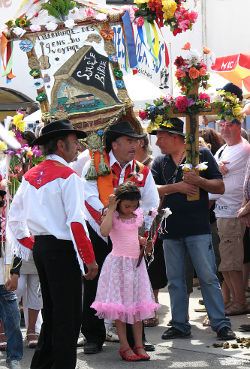
The annual
Gypsy pilgrimage of Sainte Sara, at Les Saintes Marie de la
Mer, in May
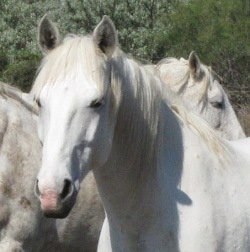
Nearby
French cities, monuments and tourist
attractions you might like to visit
- Roman Provence - Arles, Saint Rémy
- Nimes - the Rome of Provence
- Marseilles
- The Papal palace at Avignon
- Cathar castles (Languedoc)
- The Yellow train of the Pyrenees
- The Ardèche Gorge - northeast of Avignon: remarkable limestone gorge and spectacular Caverne du Pont d'Arc museum
- Other tourist attractions in France
Photo credits :
Gypsy pilgrimage: photo by Kahala
Licenced under Creative Commons
Other photos © About-France.com
